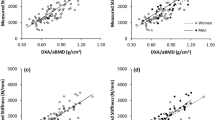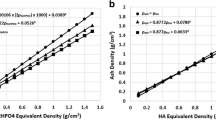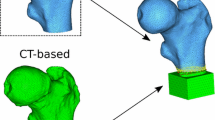Abstract
The hip structure analysis (HSA) method was introduced to extract geometric strength information from archived hip dual-energy x-ray absorptiometry (DXA) scans acquired in large research studies. Research has shown that strength effects are not easily inferred from conventional DXA measures, so there is growing interest in the clinical community in more direct evaluation of bone strength in patients. This article reviews the factors that govern the strength of an object, how they are used in engineering simulations, and how those properties can be extracted from DXA data. It is important to recognize that that although DXA scanners can be used to measure geometric strength, they were not designed to do so. The current HSA method is fundamentally limited to evaluating bending strength in the plane of the image, so precision is sensitive to consistent femur positioning. The positioning issue and other limitations of the HSA method are discussed, as well as the critical importance of body-size scaling when interpreting bone geometry. Also discussed is how current HSA limitations could be ameliorated in a “next-generation” DXA scanner that is optimized for the purpose.
Similar content being viewed by others
References and Recommended Reading
Rontgen W: English translation by Arthur Stanton of “A new kind of rays.” Nature 1896, 53:274.
Cooper C, Aihie A: Osteoporosis. Baillieres Clin Rheumatol 1995, 9:555–564.
Hengsberger S, Enstroem J, Peyrin F, Zysset P: How is the indentation modulus of bone tissue related to its macroscopic elastic response? A validation study. J Biomech 2003, 36:1503–1509.
McCalden R, McGeough J, Barker M, Court-Brown C: Age-related changes in the tensile properties of cortical bone: the relative importance of changes in porosity, mineralization and microstructure. J Bone and Joint Surg Am 1993, 75:1193–1205.
McCalden RW, McGeough JA, Court-Brown CM: Agerelated changes in the compressive strength of cancellous bone. The relative importance of changes in density and trabecular architecture. J Bone Joint Surg Am 1997, 79:421–427.
van Rietbergen B, Huiskes R, Eckstein F, Ruegsegger P: Trabecular bone tissue strains in the healthy and osteoporotic human femur. J Bone Miner Res 2003, 18:1781–1788.
Verhulp E, van Rietbergen B, Huiskes R: Comparison of micro-level and continuum-level voxel models of the proximal femur. J Biomech 2006, 39:2951–2957.
Morgan EF, Bayraktar HH, Yeh OC, et al.: Contribution of inter-site variations in architecture to trabecular bone apparent yield strains. J Biomech 2004, 37:1413–1420.
Morgan E, Bayraktar H, Keaveny T: Trabecular bone modulus-density relationships depend on anatomic site. J Biomech 2003, 36:897–904.
Martin RB, Burr DB: Non-invasive measurement of long bone cross-sectional moment of inertia by photon absorptiometry. J Biomech 1984, 17:195–201.
Mayhew P, Thomas C, Clement J, et al.: Relation between age, femoral neck cortical stability, and hip fracture risk. Lancet 2005, 366:129–135.
Ruff C, Holt B, Trinkaus E: Who’s afraid of the big bad Wolff? “Wolff’s law” and bone functional adaptation. Am J Phys Anthropol 2006, 129:484–498.
Beck T, Looker A, Mourtada F, et al.: Age trends in femur stresses from a simulated fall on the hip among men and women: evidence of homeostatic adaptation underlying the decline in hip BMD. J Bone Miner Res 2006, 21:1443–1456.
Gluer CC, Cummings SR, Pressman A, et al.: Prediction of hip fractures from pelvic radiographs: the study of osteoporotic fractures. The Study of Osteoporotic Fractures Research Group. J Bone Miner Res 1994, 9:671–677.
Cody DD, Hou FJ, Divine GW, Fyhrie DP: Femoral structure and stiffness in patients with femoral neck fracture. J Orthop Res 2000, 18:443–448.
Bell KL, Loveridge N, Power J, et al.: Structure of the femoral neck in hip fracture: cortical bone loss in the inferoanterior to superoposterior axis. J Bone Miner Res 1999, 14:111–119.
Duan Y, Beck TJ, Wang XF, Seeman E: Structural and biomechanical basis of sexual dimorphism in femoral neck fragility has its origins in growth and aging. J Bone Miner Res 2003, 18:1766–1774
Hillier TA, Beck TJ, Oreskovic T, et al.: Predicting long-term hip fracture risk with bone mineral density and hip structure in postmenopausal women: the Study of Osteoporotic Fractures (SOF) [abstract]. Presented at 25th Annual Meeting of the American Society for Bone and Mineral Research, Minneapolis, MN, September 19–23, 2003.
Khoo B, Beck T, Qiao Q, et al.: In vivo short-term reproducibility of hip structure analysis variables in comparison with bone mineral density using paired dual-energy x-ray absorptiometry scans from multi-centre clinical trials. Bone 2005, 37:112–121.
Boivin G, Chavassieux P, Santora A, et al.: Alendronate increases bone strength by increasing the mean degree of mineralization of bone tissue in osteoporotic women. Bone 2000, 27:687–694.
Selker F, Carter DR: Scaling of long bone fracture strength with animal mass. J Biomech 1989, 22:1175–1183.
Burr DB: Muscle strength, bone mass, and age-related bone loss [review]. J Bone Miner Res 1997, 12:1547–1551.
Beck TJ, Oreskovic TL, Stone KL, et al.: Structural adaptation to changing skeletal load in the progression toward hip fragility: the study of osteoporotic fractures. J Bone Miner Res 2001, 16:1108–1119.
Petit MA, Beck TJ, Shults J, et al.: Proximal femur bone geometry is appropriately adapted to lean mass in overweight children and adolescents. Bone 2005, 36:568–576.
Forwood M, Baxter-Jones A, Beck T, et al.: Physical activity and strength of the femoral neck during the adolescent growth spurt: a longitudinal analysis. Bone 2006, 38:576–583.
Kaptoge S, Dalzell N, Jakes RW, et al.: Hip section modulus, a measure of bending resistance, is more strongly related to reported physical activity than BMD. Osteoporos Int 2003, 14:941–949.
Kaptoge S, Jakes RW, Dalzell N, et al.: Effects of physical activity on evolution of proximal femur structure in a younger elderly population. Bone 2007, 40:506–515.
Schafer BW: Local, distortional, and Euler buckling in thin-walled columns. J Struct Engrg 2002, 128:289–299.
Schafer BW: CUFSM—Elastic Buckling Prediction. 2004. Available at http://www.ce.jhu.edu/bschafer/cufsm. Accessed March 2007.
Author information
Authors and Affiliations
Corresponding author
Rights and permissions
About this article
Cite this article
Beck, T.J. Extending DXA beyond bone mineral density: Understanding hip structure analysis. Curr Osteoporos Rep 5, 49–55 (2007). https://doi.org/10.1007/s11914-007-0002-4
Published:
Issue Date:
DOI: https://doi.org/10.1007/s11914-007-0002-4




